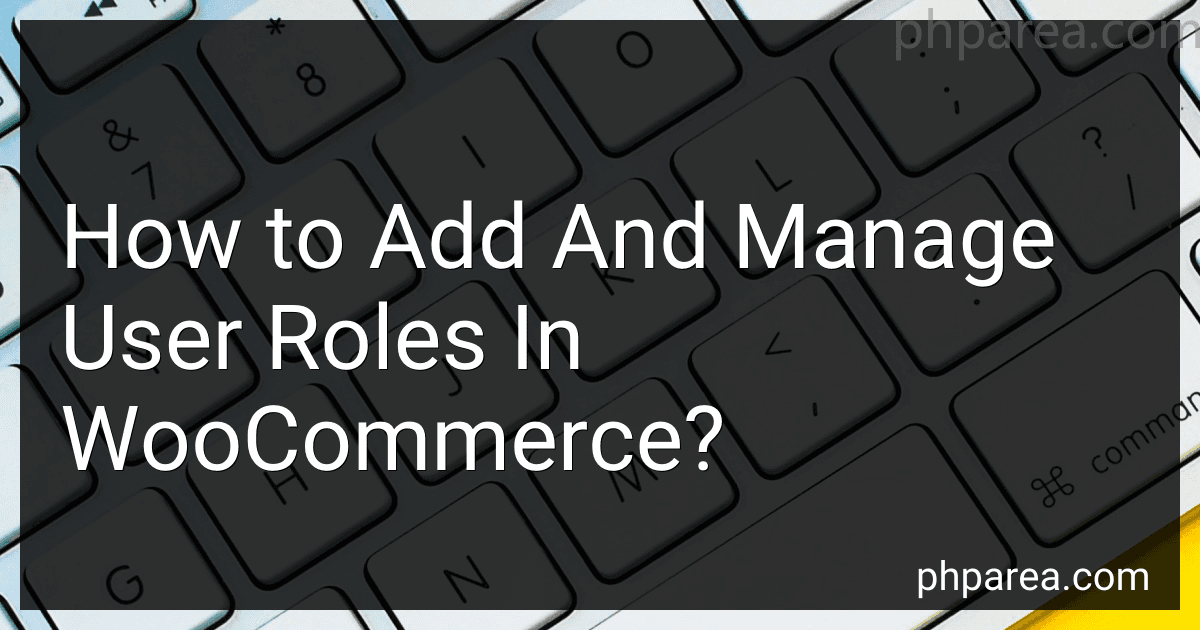Best User Role Management Tools to Buy in December 2025

The Ultimate WordPress & WooCommerce Handbook: From Setup to Success in Online Selling



WordPress WooCommerce: Tienda online con WooCommerce (Spanish Edition)



Building E-Commerce Solutions with WooCommerce - Second Edition



WordPress WooCommerce: Webshop met WooCommerce (Dutch Edition)



Formation Woocommerce: Créer et exploiter une boutique en ligne (French Edition)



Setting Up and Running an Online Store


To add and manage user roles in WooCommerce, you can follow these steps:
You can start by installing and activating a plugin called "Advanced Access Manager." This plugin allows you to have more control over user roles and their capabilities on your WooCommerce store.
Once the plugin is activated, go to the WordPress dashboard and navigate to "AAM" on the left-hand side menu. This will take you to the Advanced Access Manager settings page.
Next, click on the "Role Manager" tab. Here, you will see a list of all existing user roles on your WooCommerce site. You can also create new roles by clicking on the "Add New Role" button.
To edit the capabilities of a user role, click on the role you want to edit. This will take you to a page where you can enable or disable various capabilities for that role. For WooCommerce, you can specifically look for capabilities related to orders, products, coupons, payments, etc.
If you want to assign a specific role to a user, go to the "Users" tab within the AAM settings. Here, you can search for the user you want to modify and click on their username to access their profile.
In the user profile, you will find a section called "Roles and Capabilities." Click on "Add New Role" to assign a role to that user. You can select multiple roles if needed.
To remove a user role, go to the user's profile and click on the "x" button next to the role you want to remove.
Remember to save any changes you make along the way. This will ensure that the changes are applied correctly.
These steps should help you add and manage user roles in WooCommerce using the Advanced Access Manager plugin.
How to assign multiple user roles to a single user in WooCommerce?
To assign multiple user roles to a single user in WooCommerce, you can follow these steps:
- Install and activate a user role editor plugin like "User Role Editor" or "Members".
- Go to the WordPress admin dashboard and navigate to "Users" > "All Users".
- Locate the user you want to assign multiple roles to and click on the "Edit" link below their username.
- Now, scroll down to the "Role" section and click on the checkbox for each user role you want to assign to the user. You can select multiple roles by holding down the "Ctrl" (Windows) or "Cmd" (Mac) key while clicking on the roles.
- Once you have selected all the roles you want to assign, click the "Update User" button to save the changes.
Now, the user will have all the selected roles assigned to their account. They will have the combined capabilities and permissions of all the roles assigned to them.
What is a user role in WooCommerce?
A user role in WooCommerce refers to the different roles or permissions assigned to various users on an online store built using the WooCommerce plugin. These roles determine the capabilities and actions a user can perform within the WooCommerce system.
Some common user roles in WooCommerce include:
- Administrators: They have full control over the WooCommerce store. They can manage all settings, products, orders, and other aspects.
- Shop Managers: This role is similar to administrators but with some limited functionalities. They can manage products, orders, and other settings, but they do not have access to critical settings like plugins or theme customization.
- Customers: These are regular users who register and purchase products on the WooCommerce store. They can view and manage their orders and account information.
- Subscribers: These users are subscribed to newsletters or blog updates and do not have purchasing capabilities. They can only access content and updates provided by the website.
- Contributors: These users can create and edit their own products, but they cannot publish them. An administrator or shop manager needs to review and publish their products.
The user roles in WooCommerce allow store owners to assign specific responsibilities and permissions to different users, ensuring proper management and security of the online store.
How to set up user role-based discounts in WooCommerce?
To set up user role-based discounts in WooCommerce, you can follow these steps:
- Install and activate a user role management plugin, such as "User Role Editor" or "Members".
- Once the plugin is activated, go to the "Users" section in your WordPress dashboard and click on "User Role Editor" or the relevant option provided by the plugin.
- From there, you can create new user roles or modify existing roles. Create a new user role for the group you want to offer a discount to, such as "Wholesale Customers" or "VIP Customers".
- After creating the user role, you can assign this role to specific users.
- Install and activate a discount plugin that supports user role-based pricing. A popular option is the "WooCommerce Dynamic Pricing & Discounts" plugin.
- Once the dynamic pricing plugin is activated, go to its settings page in your WooCommerce dashboard.
- Create a new pricing rule for the user role you created earlier. Set the conditions for the discount, such as the minimum quantity of products or product categories, minimum order value, or specific products.
- Configure the discount percentage or fixed amount for the user role. You can specify different discount levels for different user roles.
- Save the settings, and the user role-based discounts should now be enabled on your WooCommerce store.
- Test the discount by logging in as a user with the assigned role and adding products to the cart that meet the conditions set in the pricing rule. The discount should automatically apply when the conditions are met.
Remember to regularly review and update your user roles and pricing rules as needed to ensure your discounts are up-to-date and relevant.
How to create user roles in WooCommerce?
To create user roles in WooCommerce, you can follow these steps:
- Install and activate the WooCommerce plugin on your WordPress site.
- Go to WooCommerce settings by clicking on "WooCommerce" in the WordPress admin menu.
- In the WooCommerce settings, navigate to the "Accounts & Privacy" tab.
- Under the "Account creation" section, check the box that says "Enable customer registration on the "My Account" page".
- Save the changes.
- Now, go to the "Users" section in the WordPress admin menu and click on "Add New".
- Create a new user account or select an existing user account.
- Under the "Role" dropdown menu, choose the desired role for the user. The default roles are "Customer", "Shop Manager", and "Administrator".
- If you want to create custom roles, you can install a user role management plugin, such as "Members" or "User Role Editor".
- Configure the custom user roles in the plugin settings and assign specific capabilities or permissions to each role.
- Save the changes and the new user roles will be available for selection when creating or editing user accounts.
Note: It's recommended to be cautious when assigning user roles and capabilities to ensure proper access control and security on your WooCommerce site.
What is the role of "Subscriber" in WooCommerce?
In WooCommerce, a subscriber is a user role with limited permissions and responsibilities. The role of a subscriber primarily focuses on managing their own account and interacting with the website as a customer.
The main responsibilities and capabilities of a subscriber include:
- Account Management: Subscribers can edit their profile, change their password, and manage personal information associated with their account.
- Commenting: Subscribers can leave comments on blog posts and engage in discussions on the website.
- Newsletter Subscription: Subscribers can opt-in to receive newsletters or promotional emails from the website.
- Product Reviews: Subscribers can leave reviews for products they have purchased or used.
- Wishlist: Subscribers can create and manage their own wishlist on the website, saving items for future purchase.
However, subscribers do not have access to the administrative backend of the WooCommerce store. They cannot create or manage products, view sales reports, customize the website appearance, and perform other administrative functions. Subscribers are primarily focused on their own personal interactions and preferences as customers on the site.
What is the default user role in WooCommerce?
The default user role in WooCommerce is "Customer".
How to set up different pricing for different user roles in WooCommerce?
To set up different pricing for different user roles in WooCommerce, you can follow these steps:
- Install and activate the WooCommerce plugin on your WordPress website. Go to "Plugins" > "Add New" and search for WooCommerce. Once found, click on "Install" and then "Activate."
- Set up your user roles. WooCommerce doesn't have built-in user roles, so you'll need to install a plugin like "User Role Editor" or "Members." Go to "Plugins" > "Add New" and search for one of these plugins. Install and activate the plugin you choose.
- Once the user role plugin is activated, go to "Users" > "User Role Editor" or "Role Editor" to manage user roles. Create the user roles you need, such as "Wholesale Customers" or "VIP Customers."
- Configure the pricing for each user role. Go to "WooCommerce" > "Settings" > "Products" > "General." Here, you'll find the "Enable role-based pricing" option. Enable it and click on "Save changes."
- Go to the "Products" tab on the WooCommerce settings page. Here, you can set up different prices for each user role. Select a product, and under the "Product data" section, you'll find a "General" tab. Click on it.
- Scroll down to the "Role-Based Pricing" section. Here, you can enter the specific price for each user role. For example, you can set a higher price for "Guests" and a lower price for "Wholesale Customers."
- Save the changes, and repeat this process for any other products that require different pricing based on user roles.
By following these steps, you'll be able to configure different pricing for different user roles in WooCommerce.
